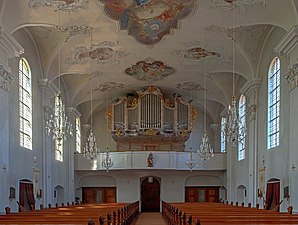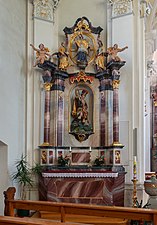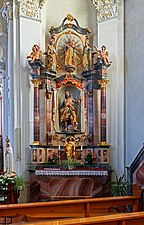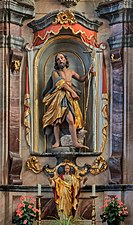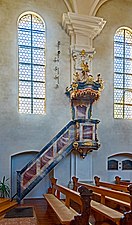Mundelfingen
|
Mundelfingen
City of Hüfingen
|
|
|---|---|
| Coordinates: 47 ° 52 ′ 6 ″ N , 8 ° 28 ′ 0 ″ E | |
| Height : | 732 m |
| Area : | 15.29 km² |
| Residents : | 677 (Jun 30, 2013) |
| Population density : | 44 inhabitants / km² |
| Incorporation : | 1st January 1975 |
| Postal code : | 78183 |
| Area code : | 07707 |
|
Center from the east
|
|
Mundelfingen is a village and today a district of Hüfingen in the southwest of Baden-Württemberg in the Schwarzwald-Baar district . The next larger towns are Hüfingen, about 6.5 km north, Bonndorf about 11 km southwest and Blumberg about 6 km southeast. Schaffhausen in Switzerland is about 23 km south.
geography
The village on the Baar high plateau in the southern Black Forest has a height of 500 to 800 meters. The Aubach , which rises in the Kohlwald , first flows through the village, then has a 10 meter high waterfall and flows into the Wutach near Aselfingen . See also: List of waterfalls in Germany
structure
In addition to the core village, the village consists of the upper, lower and rear villages. In the 1970s and 1980s, the then new development area "Alpenstrasse" and "Auf Breiten" was developed with two-family houses, in the 1990s the Randenweg was extended with residential houses by a spur road parallel to the Aubach and the new development area "Auf Engelen" has been built since the turn of the millennium. Furthermore, four farmers have been relocated to newly built farms around the village. Last but not least, there is an old farm on the young cattle pasture in a valley between Mundelfingen and Aselfingen , currently trading as "Birk-Hof".
history
The place was first mentioned in the year 773 as "Mundulfingen" in a document of the Lorsch Codex on the occasion of a donation to the Lorsch Monastery . Another mention was made in 802 in a deed of donation from Count Berthold to the St. Gallen monastery as "Munolvingas". At first the village belonged to the Zähringers with all their duties and rights until the Fürstenberg family replaced them in 1283. The place remained with the Fürstenbergers until 1805. From 1380 to 1619 the Fürstenbergers enfeoffed the nobles of Schellenberg in Hüfingen with the village.
In October 1524 and April 1525 peasant troops marched through the village to defend themselves - in the course of the peasant war - against the blackmail and oppression of the noble lords. The Thirty Years War in Mundelfingen caused significantly worse things : After the famine and poor harvests in 1622 and 1628, the village was economically weakened; when the French and Swedes invaded the village in 1632 and plundered and devastated it, Mundelfingen was close to ruin. It took decades for the village to overcome the severe blows of fate. He was granted a few years of peace and quiet: The Palatinate War of Succession in the late 17th century and the billeting and war deliveries during the Napoleonic period prevented economic prosperity for a long time. In the Franco-German War of 1870/71, 12 citizens' sons took part, and 116 soldiers were drafted during the First World War. During the Second World War, the village was to be held by 70 German teams against the French advancing from Döggingen. In Mundelfingen 48 houses were destroyed in the course of the war; the official estimate of the damage was 34,000 gold marks.
For centuries, agriculture was the main source of income for the residents of Mundelfingen. Only with the arrival of industrialization did the social structure of the village begin to change. The number of those who are still employed in agriculture has decreased considerably over the last two decades and more and more residents are finding their income as commuters in the surrounding communities with industrial companies.
Incorporations
The municipality of Mundelfingen was incorporated into the city of Hüfingen on January 1, 1975 as part of the administrative reform in the municipal area.
language
Alemannic is spoken by the majority of the inhabitants in the village .
Culture and sights
Buildings
- Aubachhalle, a multi-purpose hall
- Catholic Baroque Church of St. George by Peter Thumb
Economy and Infrastructure
traffic
The village is on Landesstrasse 171, which connects the cities of Bonndorf and Donaueschingen , 19.4 kilometers apart . In addition, a district road begins to Döggingen and one to Sacrifice things . The SBG bus line 7260 serves all villages on Landesstraße 171.
Educational institutions
The village has a primary school with grades 1 to 4, the Schellenberger School on the ground floor of the town hall. There is also a Catholic public library.
Personalities
- Johann Evangelist Engesser (1778–1867), Baden politician and former director of the Catholic church section of the Ministry of the Interior in Karlsruhe, was pastor in Mundelfingen for several years
- Willibald Strohmeyer (1877–1945) Catholic priest
literature
- Willibald Strohmeyer: history of the village and the parish Mundelfingen in: Freiburg Diocesan Archives , Volume 36 / 37 , 1908/1909
Web links
Individual evidence
- ↑ Birk-Hof
- ↑ Minst, Karl Josef [trans.]: Lorscher Codex (Volume 5), Certificate 3277, June 13, 773 - Reg. 903. In: Heidelberger historical stocks - digital. Heidelberg University Library, p. 138 , accessed on February 21, 2020 .
- ^ Federal Statistical Office (ed.): Historical municipality directory for the Federal Republic of Germany. Name, border and key number changes in municipalities, counties and administrative districts from May 27, 1970 to December 31, 1982 . W. Kohlhammer, Stuttgart / Mainz 1983, ISBN 3-17-003263-1 , p. 517 .
- ^ Antonius van der Linde : Kaspar Hauser : Eine neueeschichtliche Legende , Chr. Limbarth, Wiesbaden 1887, p. 123, footnote 1





